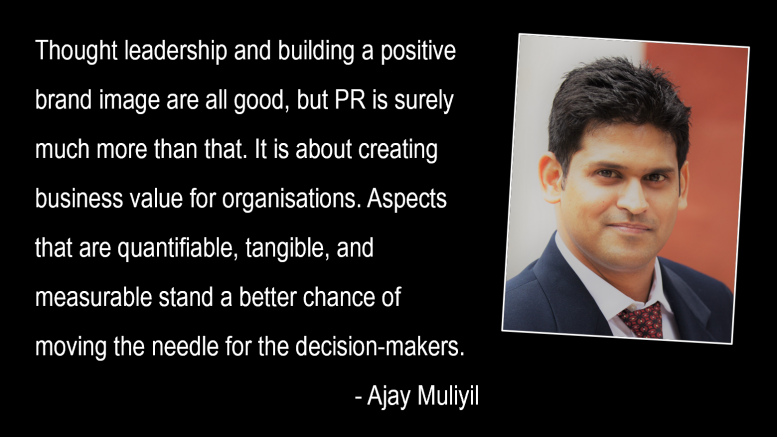The headline is not aimed to be clickbait, though it might seem so. The ‘Big B’ you may be wondering about has nothing to do with the Shahenshah of B-town, rather what I am referring to is ‘Business Impact.’ What prompted me to write this article, is what I’ve observed and I’m sure many of you too, that among the C-suite and decision makers within many organisations – PR and Business are perceived as two diametrically different things. How can PR possibly drive any business outcome? Isn’t it something under the purview of the marketing and sales function. PR is at most limited to media relations, interviews, press conferences, crisis management and launch events. Hence, businesses don’t see any real business impact of this exercise. Even if they do, we don’t show it to them the way a sales and marketing function does – in terms of revenues, dollars, profits, % growth, etc.
Unlike in advertising you don’t have a CTA and various lead generation techniques that can be adopted. Great advertising and effective promotional activities lead to sales and footfall, which translates to business impact. That is what they are concerned about at the end of the day. The problem lies in how we firstly measure PR and position the business impact to people in the corner office. Let’s delve a bit into how we measure it currently and how we could make it better.
Public Relations consultancies majorly use AVE (Advertising Value Equivalent). These metrics, as we stated earlier do not necessarily make much of a difference to the client in the larger scheme of things. Firstly, why should we even have AVE as a benchmark of measurement? We do not see such comparisons in other disciplines of marketing. It is important to measure PR on a different scale maybe. It is high time.
Now if PR were to elevate itself in the big boys league, the way PR needs to be positioned will need to be way different. Thought leadership and building a positive brand image are all good, but PR is surely much more than that. It is about creating business value for organisations. Aspects that are quantifiable, tangible, and measurable stand a better chance of moving the needle for the decision-makers. The impact on a company’s stock price, fueling business inquiries and partnerships, VC and PE interest for funding, and attracting top talent are all aspects where PR plays a role. Taken in totality it might be fair to say that the ‘Business Impact’ through PR is unlike any other disciplines of marketing. Hence, presenting only AVE as the measure of what PR does for a client is a very shallow projection of the discipline and it does more disservice to PR than good. By all means have AVE, if you must, but let’s figure out a mechanism where PR and Business Impact become synonymous.
Do not we all PR practitioners believe that in this day and age where user-generated content (UGC) and the importance of influencers have become all-important, our old ways of measurement might be a tad irrelevant?
Moving beyond traditional metrics like AVE let us try to evaluate an alternate measure of business impact delivered through PR. Broadly, our new formula would be.
PR Impact = (Reach x Engagement x Sentiment) / Cost
This formula considers three key aspects and divides them by cost to determine the overall return on investment (ROI) of your PR efforts. Reach tells us how many people saw our message through media coverage, social media mentions, or event attendance. We can track this with website traffic, social media impressions, or media circulation figures. Engagement goes a step further, measuring how actively people interacted with our content. This includes social media shares, comments, website click-through rates, or inquiries generated from media coverage. Finally, sentiment analysis gauges the overall perception of our brand or message conveyed through public relations activities. By analysing online comments, media coverage, and social media mentions, we can understand if the perception is positive, negative, or neutral. There are powerful tools like TrendKite, Meltwater, Impact, Hootsuite, etc, available to help us with this process.
Here is how to use the formula:
- Quantify each element: Assign a numerical value to each element (Reach, Engagement, Sentiment) based on your chosen measurement method.
- Combine the elements: Multiply Reach, Engagement, and Sentiment to get a composite score representing the overall impact.
- Divide by Cost: Divide the composite score by the total cost of your PR campaign to determine the PR impact relative to the investment.
Now, let us delve a bit on what are the pros and cons of using this methodology. Let us get into the pros first. This approach to measuring PR success goes beyond just counting eyeballs. It considers both how many people saw your message (reach) and how they reacted to it (engagement), giving a clearer picture of whether your message resonated. Analysing sentiment adds another layer, revealing if the perception generated is positive. Finally, dividing by cost provides a relative ROI, allowing you to judge the value your PR efforts delivered for the resources invested.
Onto the cons. This formula is not perfect. Assigning values to reach, engagement, and sentiment can be subjective depending on how you measure them. Additionally, some PR wins, like a boost in brand reputation, are tough to quantify directly.
Measuring PR impact requires a multifaceted approach. Set clear goals and tailor your measurement methods to reflect them. Combine hard data (reach, engagement) with qualitative analysis of media and social media sentiment. Track how PR efforts influence key business metrics (sales, traffic) over time, keeping in mind the long-term impact on brand reputation and relationships.
Hence, we will constantly need to refine our measurement approach as we learn more about what resonates with our audience and drives positive outcomes for our business. This might be a time-consuming exercise but is more significant to the C-suite who need to know the impact on business vis-à-vis investment in PR. This is an attempt to look at options as the industry, media landscape, and technology around us evolve. PR 2.0 if you may.
The views and opinions published here belong to the author and do not necessarily reflect the views and opinions of the publisher.



Be the first to comment on "Moving Beyond AVE: Measuring PR’s Big B"